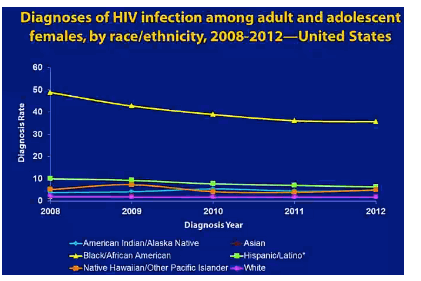 |
 |
 |
| |
Access to care up--and so is sexual risk--among US black women in high-AIDS cities.....but almost 50% of US women with HIV not in regular care
|
| |
| |
Almost half of US women with HIV not in regular care in CDC analysis...."improvement in care and treatment outcomes are needed for all females particularly with emphasis on younger females & eliminating disparities in viral suppression among race/wthnic groups"......
http://www.natap.org/2015/CROI/croi_16.htm
Black women have diagnosis rates 19 times higher than white women (picture of graph below), although new infection rates have gone down. In 2012 women accounted for 20% of all HIV infections in the USA, and even though diagnosis has decreased among all females black females continue to be disproportionately affected. Studies show females have lower viral suppression rates than males and disparities exist in care & treatment by race/ethnicity. In this CDC study viral suppression was 44% for women and retention in care was 52% for women overall. Viral suppression was 42% for Black/African-Americans, 47% for Whites and 49% for Latinos

CROI 2015, February 23-26, 2015, Seattle, Washington
Mark Mascolini
Access to healthcare and HIV testing improved among poor African-American women from 2006 to 2013 in cities with high AIDS prevalence, according to an 11,000-woman study by the Centers for Disease Control and Prevention (CDC) [1]. The proportion of women reporting high-risk sex also rose during the study period.
The CDC team observed that black women accounted for 29% of new HIV infections among adult and adolescent blacks in 2010--a 21% drop from 2008. Reasons for this fall are unknown, and the CDC hypothesized that improvements in healthcare use and socioeconomic factors may be at the root. They conducted this study to test that hypothesis.
The investigators mined data from National HIV Behavioral Surveillance (NHBS) from 2006, 2010, and 2013. The NHBS monitors HIV risk behaviors, HIV testing, and HIV prevention services in populations at high risk for HIV infection. Respondents (1) had vaginal or anal sex with 1 or more opposite-sex partners in the past 12 months, (2) lived in the city where sampled, (3) ranged in age from 18 to 60, (4) were not transgender, and (5) could complete an interview in English or Spanish. This analysis focused on 11,065 African-American women living at or below the poverty level in 2006, 2010, or 2013 in more than 20 US cities with high AIDS prevalence. Statistical analysis comparing year-to-year changes adjusted for education and city.
From 2006 to 2010 to 2013, the CDC charted significant gains in proportions of women who (1) ever had an HIV test (from below 80% to above 80%), (2) had health insurance (from about 60% to almost 80%), and (3) visited a healthcare provider in the past 12 months (from below 80% to above 80%) (P < 0.01 for all; see charts at e-poster link below).
Over the same 3 survey years, the CDC logged significant drops in percentage of women who were (1) unemployed, (2) had an annual income below $10,000, (3) injected drugs in the past 12 months (from 6% in 2006 to 3% in 2010 and 3% in 2013), or (4) had any bacterial sexually transmitted disease diagnosis in the past 12 months (from 14% to 11% to 10%) (P < 0.01 for all). The proportion of women who used crack cocaine remained around 18% across the study years.
Rates of risky sex generally rose across the three survey years. Specifically, proportions rose for women who had (1) condom-free vaginal sex the last time they had sex (from below 80% to above 80%), (2) condom-free anal sex the last time they had sex (from 8% to 13% to 10%), (3) three or more sex partners in the last 12 months (from below 40% to above 40%), (4) a most-recent male sex partner who ever had sex with a man (from 3% to 4% to 8%), and (5) a most-recent sex partner who ever injected drugs (from 11% in 2010 to 13% in 2013) (P < 0.01 for all).
Because the analysis involved women at or below the poverty level in cities with high AIDS rates, the CDC team cautioned that the results may not apply to all African-American women. They stressed the need for more research "to fully understand the factors that have contributed to the recent decline in new HIV infections among African-American women."
Reference
1. Ivy W, Paz-Bailey G. Trends in healthcare access and HIV risk behaviors--African American women, 2006-2013. CROI 2015. February 23-26, 2015. Seattle, Washington. Abstract 850. For
the e-poster: www.croiconference.org/sites/default/files/posters-2015/850.pdf
----------------------
Reported by Jules Levin
Trends in Healthcare Access and HIV Risk Behaviors—African American Women, 2006-2013
by Wade Ivy, III, Gabriela Paz-Bailey, and NHBS Study Group
Division of HIV/AIDS Prevention, National Center for HIV/AIDS, Viral Hepatitis, STD, and TB Prevention,
U.S. Centers for Disease Control and Prevention, Atlanta, Georgia




|
| |
|
 |
 |
|
|